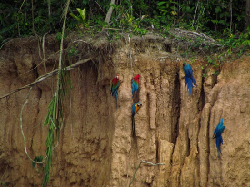Description of the Psittacidae Family that inhabits the Tambopata National Reserve, Peru
DOI:
https://doi.org/10.51252/reacae.v2i2.520Keywords:
amazon, birds, habitat, tropical rainforest, psittaciformes, rainforestAbstract
The Psittacidae family faces extinction risk due to habitat destruction and illegal trade. This study sought to record psittacine species in the Tambopata National Reserve and discuss their conservation. A transect sampling was carried out, walking and visually recording the species every kilometer. Sixteen psittacine species in 12 genera were identified, including macaws, parrots, parakeets and parakeets. Of these species, 10 are of Least Concern (LC), 2 are Near Threatened (NT) and 1 species (Primolius couloni) is Vulnerable. Pionus menstruus and Amazona ochrocephala have not yet been assessed by the IUCN. These results demonstrate the existence of endangered Psittaciformes species in Madre de Dios, Peru.
Downloads
References
Alvarez-Berríos, N. L., & Mitchell Aide, T. (2015). Global demand for gold is another threat for tropical forests. Environmental Research Letters, 10(1), 014006. https://doi.org/10.1088/1748-9326/10/1/014006
Asner, G. P., & Tupayachi, R. (2016). Accelerated losses of protected forests from gold mining in the Peruvian Amazon. Environmental Research Letters, 12(9), 094004. https://doi.org/10.1088/1748-9326/aa7dab
Atyeo, W. T. (1989). Aralichus porrectus (Mégnin & Trouessart) and related feather mite species (Acarina, Pterolichidae) from parrots of the genus Brotogeris Vigors (Aves, Psittacidae). Systematic Parasitology, 14(2), 101–111. https://doi.org/10.1007/BF00016904
Berkunsky, I., Cepeda, R. E., Marinelli, C., Simoy, M. V., Daniele, G., Kacoliris, F. P., Díaz Luque, J. A., Gandoy, F., Aramburú, R. M., & Gilardi, J. D. (2016). Occupancy and abundance of large macaws in the Beni savannahs, Bolivia. Oryx, 50(1), 113–120. https://doi.org/10.1017/S0030605314000258
Brightsmith, D. (2004). Effects of Diet, Migration, and Breeding on Clay Lick Use by Parrots in Southeastern Peru [Universidad de Duke]. http://macaw.pbworks.com/f/Brightsmith2004.pdf
Brightsmith, D. J. (2004). Effects of Weather on Parrot Geophagy in. Wilson Bulletin, 116(2), 1–12.
Brightsmith, D. J. (2005). Parrot nesting in southeastern peru: seasonal patterns and keystone trees. The Wilson Bulletin, 117(3), 296–305. https://doi.org/10.1676/03-087A.1
Brightsmith, D. J., Hobson, E. A., & Martinez, G. (2018). Food availability and breeding season as predictors of geophagy in Amazonian parrots. Ibis, 160(1), 112–129. https://doi.org/10.1111/ibi.12515
Daut, E. F., Brightsmith, D. J., Mendoza, A. P., Puhakka, L., & Peterson, M. J. (2015). Illegal domestic bird trade and the role of export quotas in Peru. Journal for Nature Conservation, 27, 44–53. https://doi.org/10.1016/j.jnc.2015.06.005
Jan, C., & Fumagalli, L. (2016). Polymorphic DNA microsatellite markers for forensic individual identification and parentage analyses of seven threatened species of parrots (family Psittacidae). PeerJ, 4, e2416. https://doi.org/10.7717/peerj.2416
Lane, D., Stotz, D., O’Neill, J., Parker III, T., & Schulenberg, T. (2010). Aves de Perú (1st ed.). Centro de Ornitología y Biodiversidad.
Ludeña, B., & Pintaud, J. C. (2017). Sexaje molecular en Psitacidae. Revista Ecuatoriana de Medicina y Ciencias Biológicas, 28(1–2), 23–29. https://doi.org/10.26807/remcb.v28i1-2.199
Monterrubio-Rico, T. C., Charre-Medellín, J. F., Pacheco-Figueroa, C., Arriaga-Weiss, S., Valdez-Leal, J. de D., Cancino-Murillo, R., Escalona-Segura, G., Bonilla-Ruz, C., & Rubio-Rocha, Y. (2016). Distribución potencial histórica y contemporánea de la familia Psittacidae en México. Revista Mexicana de Biodiversidad, 87(3), 1103–1117. https://doi.org/10.1016/j.rmb.2016.06.004
Olah, G., Butchart, S. H. M., Symes, A., Guzmán, I. M., Cunningham, R., Brightsmith, D. J., & Heinsohn, R. (2016). Ecological and socio-economic factors affecting extinction risk in parrots. Biodiversity and Conservation, 25(2), 205–223. https://doi.org/10.1007/s10531-015-1036-z
Ribas, C. C., Gaban-Lima, R., Miyaki, C. Y., & Cracraft, J. (2005). Historical biogeography and diversification within the Neotropical parrot genus Pionopsitta (Aves: Psittacidae). Journal of Biogeography, 32(8), 1409–1427. https://doi.org/10.1111/j.1365-2699.2005.01289.x
Trivedi, M. R., Cornejo, F. H., & Watkinson, A. R. (2004). Seed Predation on Brazil Nuts (Bertholletia excelsa) by Macaws (Psittacidae) in Madre de Dios, Peru. Biotropica, 36(1), 118–122. https://doi.org/10.1111/j.1744-7429.2004.tb00302.x
Ureta Adrianzén, M., Martínez Gonzales, P., Tupayachi Trujillo, R., & Zúñiga Hartley, A. (2014). Fenología de palmeras arborescentes nativas de Madre De Dios – Perú. Intropica, 9, 60. https://doi.org/10.21676/23897864.1425
Vigo, G., Williams, M., & Brightsmith, D. J. (2011). Growth of scarlet macaw (Ara macao) chicks in South Eastern Peru. Ornitologia Neotropical, 22(1), 143–153. https://www.academia.edu/24370774/GROWTH_OF_SCARLET_MACAW_ARA_MACAO_CHICKS_IN_SOUTHEASTERN_PERU

Published
How to Cite
Issue
Section
License
Copyright (c) 2023 Gustavo Martínez-Sovero, Sebastian Iglesias-Osores

This work is licensed under a Creative Commons Attribution 4.0 International License.
The authors retain their rights:
a. The authors retain their trademark and patent rights, as well as any process or procedure described in the article.
b. The authors retain the right to share, copy, distribute, execute and publicly communicate the article published in the Revista Amazónica de Ciencias Ambientales y Ecológicas (REACAE) (for example, place it in an institutional repository or publish it in a book), with an acknowledgment of its initial publication in the REACAE.
c. Authors retain the right to make a subsequent publication of their work, to use the article or any part of it (for example: a compilation of their works, notes for conferences, thesis, or for a book), provided that they indicate the source of publication (authors of the work, journal, volume, number and date).



